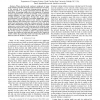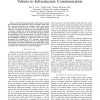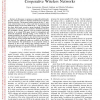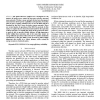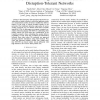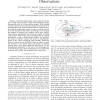WCNC
2010
IEEE
14 years 3 months ago
2010
IEEE
—When shortest path routing is employed in large scale multi-hop wireless networks, nodes located near the center of the network have to perform disproportional amount of relayin...
WCNC
2010
IEEE
14 years 3 months ago
2010
IEEE
—The newly emerged vehicular ad hoc network adopts the contention based IEEE 802.11 DCF as its MAC. While it has been extensively studied in the stationary indoor environment (e....
WCNC
2010
IEEE
14 years 3 months ago
2010
IEEE
—The selection of high-throughput routes is a key element towards improving the performance of wireless multihop networks. While several routing metrics have been proposed in the...
WCNC
2010
IEEE
14 years 3 months ago
2010
IEEE
Abstract—In this paper, we propose an output-threshold multiple relay selection scheme for dual-hop multi-branch cooperative wireless networks. The proposed scheme selects the �...
WCNC
2010
IEEE
14 years 3 months ago
2010
IEEE
Abstract—This paper presents a new upper bound on the endto-end signal-to-noise ratio (SNR) of channel-assisted amplifyand-forward (AF) multi-hop relay networks. The harmonic mea...
WCNC
2010
IEEE
14 years 3 months ago
2010
IEEE
—In this paper, we propose a new interference alignment (IA) scheme designing jointly the linear transmitter and receiver for the MIMO interference channel system, using minimum ...
WCNC
2010
IEEE
14 years 3 months ago
2010
IEEE
—The IEEE 802.15.4 standard was developed for the purpose of media access control of low power wireless personal area networks. Wireless sensor network devices have the general c...
WCNC
2010
IEEE
14 years 3 months ago
2010
IEEE
—The Disruption Tolerant Networks (DTNs) are vulnerable to insider attacks, in which the legitimate nodes are compromised and the adversary modifies the delivery metrics of the ...
WCNC
2010
IEEE
14 years 3 months ago
2010
IEEE
—We describe our experience from the implementation of the T-MAC protocol for wireless sensor networks in the open-source Castalia simulator. Notwithstanding the popularity of th...
WCNC
2010
IEEE
14 years 3 months ago
2010
IEEE
—Controlled mobile helper nodes called data ferries have recently been proposed to bridge communications between disconnected nodes in a delay-tolerant manner. While existing wor...
